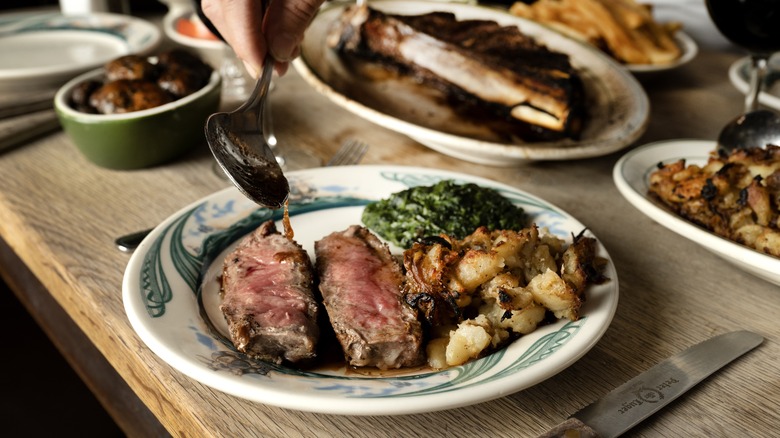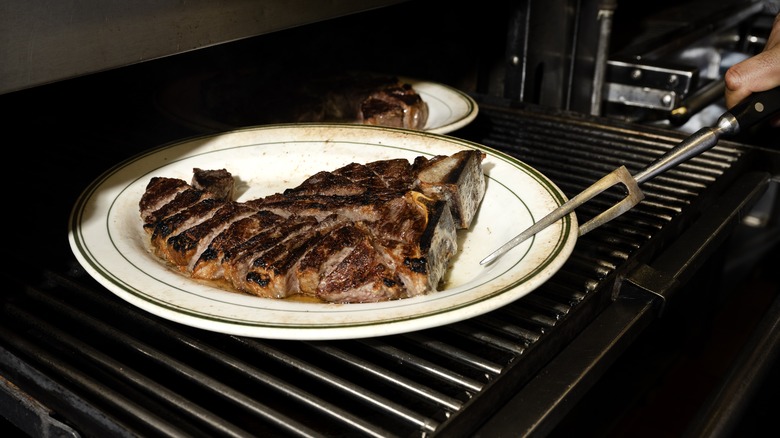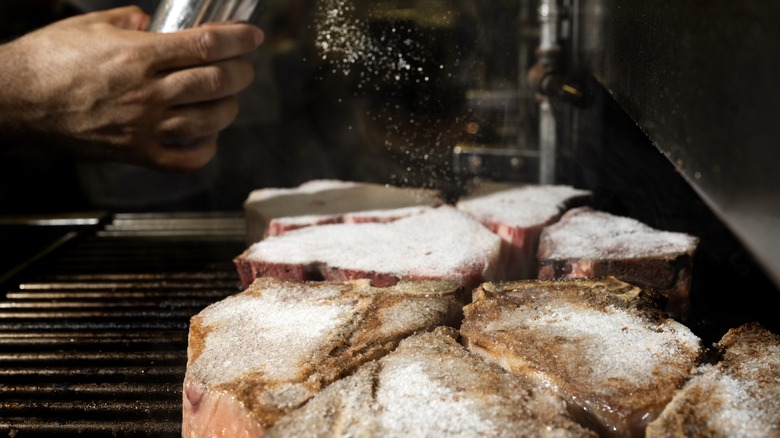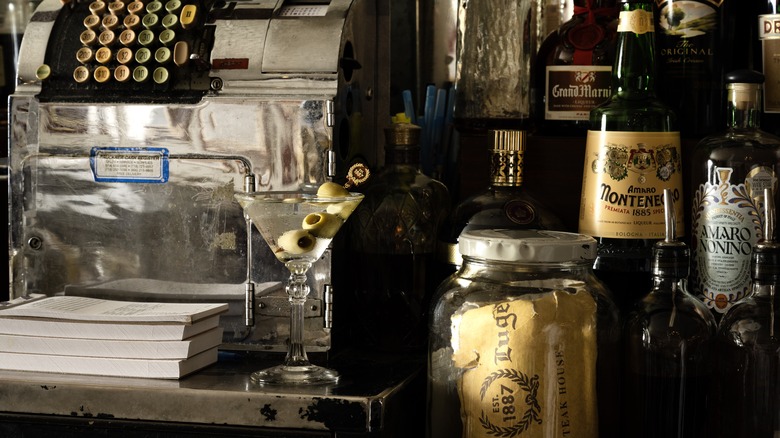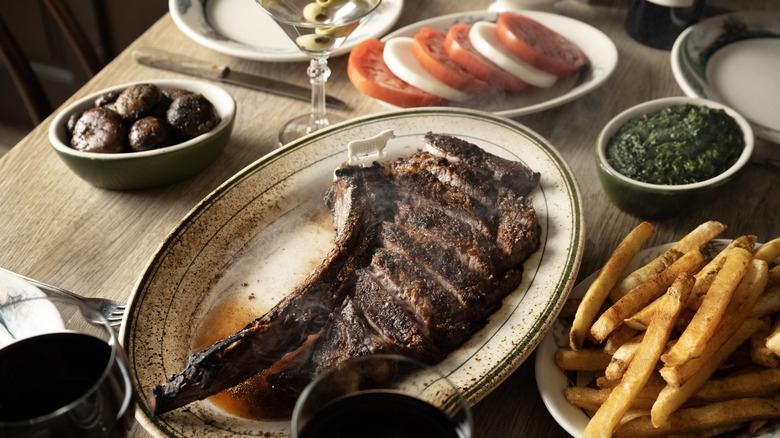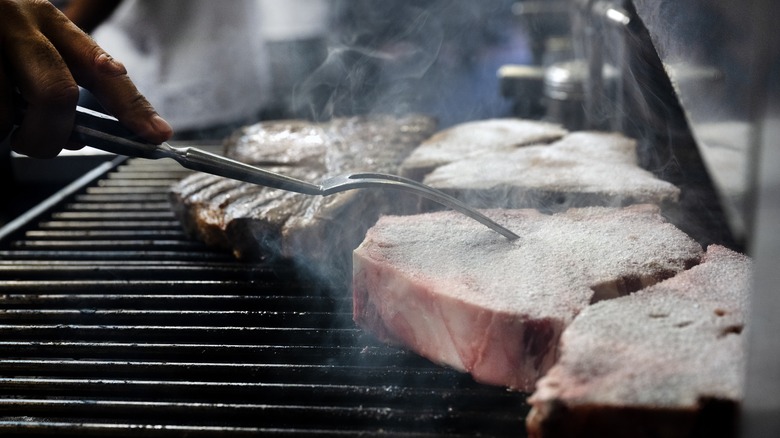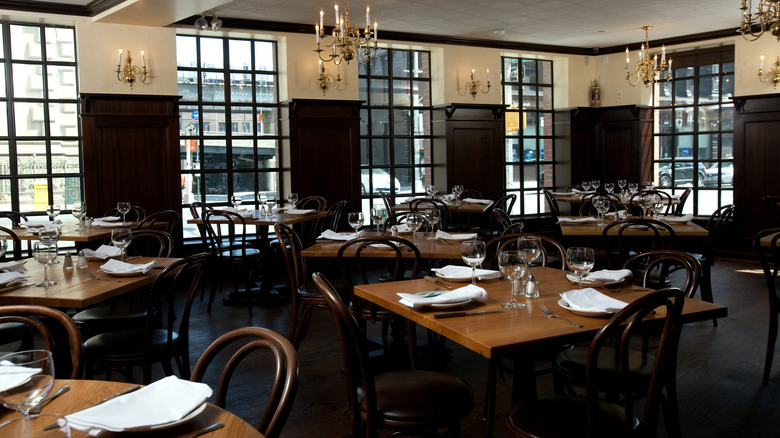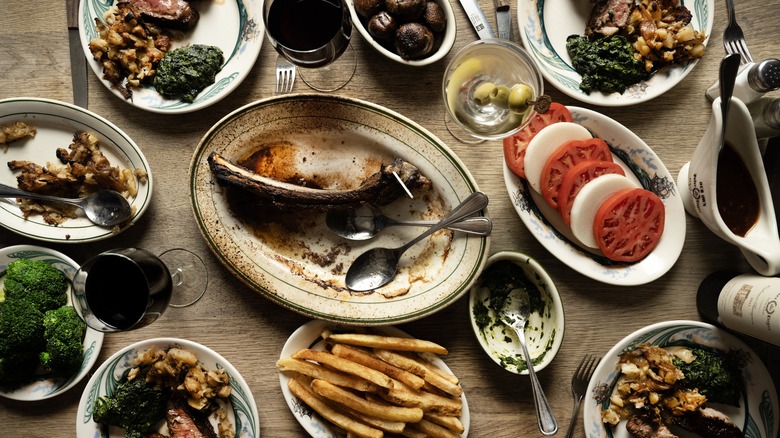Peter Luger Steak House VP On 136 Years, Top Steak Tips, And A New Vegas Outpost - Exclusive Interview
Brooklyn-based Peter Luger Steak House boasts one of the longest histories in the New York City restaurant scene. First opened in 1887 under a different name ("Carl Luger's Café, Billiards and Bowling Alley"), the restaurant quickly became a favorite. After owner Peter Luger's passing, though, the steakhouse fell out of favor — creating the perfect opportunity for longtime fan Sol Forman to purchase the establishment.
That was decades ago, and since then, the Forman family has returned Peter Luger Steak House to its initial glory and beyond. Now, the restaurant is a staple for a range of notable names, New York City residents and otherwise, from politicians to sports stars, pop stars, and actors. It's renowned for its limited menu that focuses on quality, not quantity, and it just opened an outpost in Las Vegas. Today, multiple generations of the Forman family oversee the restaurant, including vice president and co-owner Jody Storch; we spoke with Storch to learn more about the restaurant's longevity, new Vegas location, and her top tips for cooking steak at home.
Sticking to the basics
The restaurant has been open for an extremely long time. What would you say is the secret to its longevity?
Sticking to the basics, which was something that was very important for our family — the idea of getting the best possible meat that you could serve the customers, because, despite what you do for preparation, or if somebody does a special sauce ... it's never as good as starting with the best quality meat. That's always been crucial for us. We go to the market several times a week, and we hand-select all the [steak] for the restaurant. It's very important to actually look at each piece and make sure the quality is there. Quality has been the key to our longevity.
Walk me through the process. How does the steak get from the meat market to the table? What does that process look like, and is it something that home cooks can even replicate at home?
To mimic our flavor at home, you would have to go to a top-end butcher and get a fine piece of quality beef. We go to the markets, and we look at only USDA prime. Only the top percentage of meat that's graded by the U.S. Department of Agriculture gets that specific grade of prime, and once you look at prime, there's a vast range of high-end prime [to] low-end prime. You could sometimes look at a piece of meat and say, "Oh my God, did the grader have a fight with his wife this morning? Is he in a bad mood? How did he make this prime?" We used to call it "prime crime," because if something was very poor or plain looking, we would reject it.
We're always looking for abundant marbling. When we go to the market and see the hindquarters hanging there, you're looking for a rotund, filled-out carcass, which indicates that the animal had good eating. The fat is abundant, the marbling is abundant, and it's more like a fine flecking dispersed throughout the meat than a heavy, coarse, ropey marbling.
This is something that took us some time. My grandfather got involved with the restaurant back in 1950, where he bought it because the children of the owner no longer wanted to run it. It was his idea that if we're going to be a steakhouse, we have to learn what the best meat is and how to get our hands on it.
My grandmother spent two years in the meat market with a retired grader from the USDA, and he taught her what to look for. All he wanted as repayment was a TV. It's funny. He was so appreciative that someone was interested in his life and skill set ... My grandmother learned this skill. She taught it to my mom ... and she taught it to my Aunt Amy and to me. We've passed this on to the next, fourth generation. This is one of the key factors in keeping the restaurant at a high level.
It's very dramatic
What does the process look like from there?
Each of us has our own brand. It's like a metal hammer. When we like a piece of meat, we whack it with this brand. The next day, we send our driver to go pick it up, and this way, he knows that we selected these short loins. Then, they bring the meat to either our Brooklyn or Great Neck location. In each of these facilities, we have a dry-aging room, which is where you keep the meat in a temperature and humidity-controlled environment. It allows the fibers of the meat to break down, the enzymes to break everything down, and affords it a specifically dry-aged flavor, which some describe as a mineral-ly, earthy sort of flavor. After a period of time, when we feel it's reached its full potential, we release it to our butchers, who cut it on the bandsaw every day and send it up to the kitchen, and it's used that day.
In terms of the cooking process, we have broilers that achieve a very high level of heat, which is one tricky thing when you're making steak at home. A home broiler doesn't really achieve that [level of] heat ... I have some tricks that I like when I'm cooking steak [at home], and I'll tell you about those, but at the restaurant, [they] take the steak, they throw kosher salt on it, they throw it on the broiler, and then they take it off. They put it on a platter with some clarified butter on the bottom, and they cook it again. They slice it, and when it's about to come off the broiler, they have the waiter [standing] there. They beep the guy on his beeper and he's waiting there to pick it up, and then he goes running with it sputtering to the table.
There's a music to it. When you're sitting in the restaurant, you hear this popping, cracking sound of waiters running by with these sizzling hot platters. It's very dramatic and it's an exciting thing for the customers, because they know they're getting it straight off the broiler.
A special place to be
As you mentioned, this is a family business and you're the third generation. Was there ever any question for you that you would fall into this career path?
Yeah, I had many questions. My mom was a real character. She believed in the work ethic and keeping the family together. In college, I had different ideas. At one point, I thought I'd be an illustrator and do political cartoons, and she looked at me like I was out of my mind, like, "How are you going to feed your family?" She called it "my doodles," which was sort of insulting, but whatever.
Then, I was supposed to go to law school and I deferred, and I was like, "Okay, I'll try the business."
It was a privilege for me to work with all the generations. My grandfather was well into his 80s when I started, and it was a special time to be here. It was my grandfather who I don't think even had a high school diploma. He put himself through by being a scruffy, hard-working guy with a lot of confidence. He believed in Luger's and making it this great institution.
I got to work with him, my grandmother, my mother, and my aunt. My aunt is still very involved. She's in every day, really busting my chops. I'm in my 50s, and I'm still getting my chops busted by my 84-year-old aunt. It's a special place to be. It was always about creating this environment where we were giving the customer something special that they couldn't get anywhere else. It was in the days before all the clones and before steakhouses really took off; there was a genuine nature about us. You come here and you're going to get a great piece of meat. You're going to get a great steak. It's simple. You're not going to get any vertical sprigs of rosemary standing up in your mashed potatoes. It's going to be simple, and it's going to be the best.
That's what we've tried to stick with through all these years. The fourth generation is dedicated in the same way, and it's great to be able to still work with family. Thank God we all get along. We all have our strengths and our weaknesses, and we try to bolster each other, and it's been amazing.
What to order
If you're going to eat at the restaurant, what do you typically have?
You'd start off with the [sliced] tomato and onion ... You chop in some sizzling bacon. You get these strips of bacon that are thrown on the broiler. There's no fancy prep or anything. You cut it all up together. You put a little bit of the Luger house sauce on it, and that's a terrific appetizer.
Get a Caesar salad. We just started with a crab cake a few months ago and that's really taking off.
Then, for the main dish, most people take the porterhouse steak and either French fries or spinach — just simple. I don't think baked potatoes are a big thing with us; it's either the French fries [or] the hash browns, the creamed spinach, and the steak.
Then, for dessert, our most popular dessert is either the holy cow sundae or the cheesecake, which is fantastic. It's all served with our homemade schlag, which is like a whipped cream. These big bowls come to the table, and they put a huge plop of it down on your plate. It's good in the coffee. When I was on an Atkins diet, I convinced myself that it was a perfectly legitimate lunch — a cup of schlag at my desk.
A lot of notable people have eaten at the restaurant. Do you have any notable regulars or any celebrity encounters that have stood out to you over the years?
What's nice about our restaurant is it's a little bit stuck in a time warp. I remember when I started working there, in the mid-1990s, U2 came and they had a party in the upstairs dining room. I was so excited. The next day, I went in and I said to the waiters, "Oh my God, how was it? You just had U2." They're like, "What's U2?"
I was flabbergasted. They had no idea that this was a major rock [band]. It was funny, and that's what's special about us. It doesn't really matter who you are; it is what it is. Whether you're a celebrity or a Wall Street person or a plumber, you're going to get the same treatment. They see you as they see you.
[Rudy] Giuliani used to come a lot ... Certain sports stars, [Adam] Sandler... When I was pregnant with my son, Denzel Washington came and my mother had to restrain me. I was like, "Oh my God, I'm going to have him sign my belly." She's like, "You will not have him sign your belly." I was so excited. He was one of my faves.
One thing that's really big with our readers are secret menus and finding those special off-menu items. Do you have anything like that at Peter Luger Steak House?
The bacon [appetizer], years ago, was not even on the menu. It was an employee snack. The guys would take bacon. They'd cut it really thick on the slicer, and they'd throw it on the broiler, and it would come out really crispy and delicious. The customers would see the waiters eating it at the table on their lunch break, and they'd be like, "Oh my God, we want that." Then, all the customers were getting the bacon. We were like, "Why aren't we putting this on the menu?" It turned out to be one of our hottest-selling appetizers.
Tips for making the perfect steak at home
You mentioned tips for making steak at home — tell me about those.
In the restaurant, we have those very hot broilers, which get a terrific crust on the meat. I found, with experimenting at home, you don't really get [that]. What I tell customers [is], I personally think if you use a cast iron skillet, you're able to get that amazing crust without using the broiler at all.
I let the steak get to a room temperature. I don't take it right out from the refrigerator. I let it sit on the counter a little while, until it is not cold to the touch. I liberally sprinkle it with kosher salt on both sides, and then let that heavy iron pan get very hot.
The trick is, don't keep touching it. Let it go, and don't keep poking and prodding and checking. Every time you do that, juices are coming out and you're torturing the meat. In our family, we like everything very rare. On a steak cut, let's say an inch and a half [thick], I do five, six minutes on each side and then I take it out.
If it's still too rare on the inside — sometimes I have guests, they want it a little more cooked — I'll take the skillet and I'll put in a hot oven for a couple minutes. But we really like it bloody in our house, so we just take it right from there, and then we slice it and it comes right to the table. It gets that nice crusty char on the outside.
Are there any biggest mistakes that you see home cooks making, when they're cooking steaks? Anything that they need to avoid?
Like I was saying before, don't keep poking it and checking it. Sometimes people cut a little bit into it. They want to make sure it's the right temperature, so they slice a little bit into it, and then all the juices run out. I would avoid that. If it's a great piece of meat, I would also avoid heavy seasoning. You just need salt. I don't think you need anything superfluous on it. If you're starting with great meat, you'll end up with a great taste. Keep it simple.
Let's say you've cooked this perfect steak at home and then you have leftovers. What's the best way to go about reheating those leftovers?
I don't like steak the next day reheated. I don't mind it cold on a great piece of toasted bread. That's how I would eat it. I'm not a big reheater person, but that's a personal thing. I've seen my kids, many times, nuke it for a couple minutes, but to me it tastes very different once you reheat it. It's better [to] stick with it cold.
So your kids will put it in the microwave?
My kids [will], but they do a lot of crazy stuff that I don't agree with.
Recreating a classic in a new locale
You recently opened a Vegas location. Why did you decide to do that? Is there anything new or different about this location versus the original New York location?
People have been after us to expand for ... over 30 years. I remember Steve Wynn calling my mother from his private plane, and she'd basically hanging up on him ... I was like, "Mom, what are you doing?" And she's like, "I can't talk about this stuff now. I have a cook out sick. I've got this piece of equipment broken." She was very overcome with the necessary minutiae of every day, which you need to [be], to run a restaurant. She wasn't into any kind of delegating. She wanted to do everything herself, which made it difficult, if you ever think about expansion. She would never even entertain the thought.
Caesars and Gary Selesner had been after us for years and years, and I always felt bad because he's such a nice guy. I was like, "You could come and talk to us, but I am sure we're going to say no." I didn't want to spin his wheels for nothing.
[However], he gave us such confidence that they would give us a great space, and we would build it out to our specs, and we would still be able to source the meat. It allayed so many of our fears. The truth is, it was the next generation. My nephew Dan took the bull by the horns and he's like, "You know what, I really want to do this. I want this to be my project." He did an amazing job. We just opened up. They started doing soft openings in October, and November was the real opening. It's been fantastic.
I was also concerned, because, how do you make the restaurant not look like the Disneyland version of your restaurant? They were able to achieve an elevated Peter Luger style. It still has the wood and the brick, and it has some black metal elements. It has a feel to it like it's been there for many years, which was an amazing design feat ... In terms of the meat, we still get them the meat every week. They have a beautiful dry-aging room that we set up for them, which is nicer than ours here in Brooklyn.
Our staff went down there and trained them. They had guys come here and train. It's been amazing, and the reception has been fantastic. The customers seem to love it, so we're pleased. I'm pleased and delighted.
Are there any big or notable differences in the menu there?
They have a couple of things, like a seafood tower. We never really had the space for that here or the wherewithal to put it together. It takes a whole separate room for that, because our kitchen is pretty maxed out. They have a great seafood tower that's beautiful, and that's a very popular item in Vegas. People seem to love that.
Future plans
I know it's only been open for a short amount of time, but has anything surprised you in terms of what people want or how the Vegas restaurant runs or is overall different from the Brooklyn location? Any surprises that have popped up?
In our restaurant, one difference is that the waiter is in charge of everything. We don't have busboys. We don't have runners. If your waiter is for your table, they take care of absolutely everything.
In Vegas, they have runners, they have busboys. There's more of a staff running around ... It's more involved. Ours is very basic. It's a one-man show for everything.
Any additional expansion plans on the horizon?
No, not for me. We were moving at an evolutionary pace of one place every 73 years. This has blown us away. So, for me, no.
You want to make sure you get all the kinks out. You want to make sure you're able to handle the problems that come up. In true deference to my mother, you want to be able to have a handle on problems that come up and not let anything get out of your reach. You want to be able to maintain the quality, maintain the right attitude of the staff, and you have to be careful as you expand to make sure you're capable of it.
Peter Luger Steak House runs three unique locations in Brooklyn, New York; Great Neck, Long Island; and inside Caesars Palace in Las Vegas. Visit the Peter Luger Steak House or Caesars Palace websites for information about reservations.
This interview has been edited for clarity.

